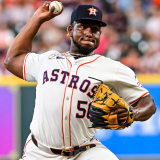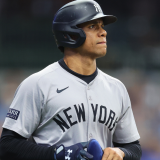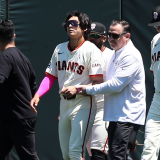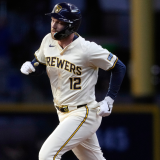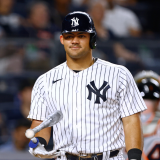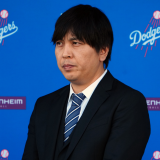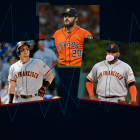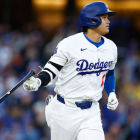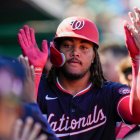I wouldn't blame you for not noticing, but one impending 2019-20 free agent came off the board within the past week: Indians lefty Oliver Perez. The veteran southpaw's 2020 option vested this past Saturday, when he made his 55th appearance of the season. He'll make $2.75 million next year with a chance to push it to $3 million before the end of the season.
Here are some other notable vesting options:
- Andrew Cashner, Red Sox: $10 million option vests with 340 innings from 2018-19. Cashner is currently at 285 2/3 innings, so there is little chance his option will vest.
- Sean Doolittle, Nationals: $6.5 million club option becomes mutual option with 100 games finished from 2018-19. Doolittle is at 84 games finished and is on the injured list. This is likely to remain a club option.
- Wade LeBlanc, Mariners: $5 million club option vests with 160 innings in 2019 and no arm injury. LeBlanc's arm is healthy, but he's only thrown 111 1/3 innings and was recently demoted to the bullpen. This probably won't vest.
Rockies catcher Chris Iannetta could've locked in a $4.25 million salary for next season with 220 starts behind the plate from 2018-19. Injuries have limited him to only 120 starts though, so it is mathematically impossible for his option to vest. Cashner's, Doolittle's, and LeBlanc's options remain in play, but again, they all seem unlikely to vest.
Here are our 2019-20 MLB Free Agent Power Rankings for August. In this week's free agent stock watch update we're going to look at two Astros pitchers on the rise and two Giants position players whose stock has taken a tumble.
Stock Up
The Astros lost Charlie Morton and Dallas Keuchel to free agency over the winter -- well, Keuchel was unsigned until June, but you know what I mean -- and Lance McCullers Jr. to Tommy John surgery, and they didn't do much to replace them. They moved Collin McHugh and Brad Peacock back into the rotation, and signed Wade Miley to a one-year deal worth $4.5 million.
Miley, 32, has proved to be one of the best free agent signings of the winter. The veteran southpaw has thrown 152 1/3 innings with a 3.13 ERA. That is a top five mark in the American League. Unlike teammates Justin Verlander and Gerrit Cole, Miley does not blow hitters away and rack up strikeouts. He succeeds with weak contact:
- Hard-hit rate: 32.8 percent (78th percentile)
- Expected slugging percentage: .355 (76th percentile)
The Astros have had a ton of success bringing in pitchers and helping them take their game to the next level (Cole, Morton, Ryan Pressly, etc.), but, in this case, Miley and the Brewers deserve the credit. Miley spent 2018 with Milwaukee and threw 80 2/3 innings with a 2.57 ERA around an oblique strain. That happened thanks to a new emphasis on his cutter:

"I added it last year when I knew I was struggling and I needed something to stay in on righties," Miley told The Athletic's Cat Garcia about his cutter last August. "I've thrown it a lot more this year than I have in the past. It's just a pitch I feel comfortable with throwing for a strike, and to expand (the zone), I can speed it up, slow it down. I'm just feeling comfortable with it."
Miley has stuck with the cutter-heavy approach this season and is showing last year's success is sustainable in a hitter's park in the DH league, not just in a small sample and in the National League. He might not offer the big velocity and bat-missing stuff teams crave, but Miley excels at managing contact. That's a valuable skill.
Miley will turn 33 in November and he's never had a major arm injury in his career. He's thrown at least 150 innings every year but one since 2012 (the oblique limited him last year), so even though he is on the wrong side of 30, the combination of durability and performance will get Miley a multi-year deal this winter. Two years and $20 million feels like his floor now.
"I saw him pitch in person a couple weeks back, and he was good. Depending on the team, I see no reason he can't perform as a No. 3 over the next couple of years. Maybe a solid No. 4 on a top-tier club," a National League executive told MLB.com's Mark Feinsand. "... He did a great job betting on himself this year."
Righty reliever Will Harris has proven to be one of the most impactful waiver claims of the last decade or so. The Astros claimed him from the Diamondbacks in November 2014 and he's since thrown nearly 300 innings with a 2.42 ERA with Houston. His 6.9 WAR since Opening Day 2015 is 11th best among full-time relievers.
Harris is having a typical Will Harris season this year, with a ton of strikeouts and not much in the way of hard contact. In fact, his 31.5 percent hard-hit rate allowed is in the 84th percentile among relievers. That's really good. As with most Astros pitchers, Harris boasts elite spin rates on his fastball (a cutter, specifically) and curveball. The underlying numbers check out.
Even in the current free agent climate, relievers are getting paid and paid well. Eleven of the 34 multi-year free agent contracts went to relievers last winter. With Dellin Betances injured and Kenley Jansen and Aroldis Chapman not locks to opt out, this winter's free agent reliever market is thin. Will Smith is the cream of the crop. Harris is in the conversation for next best.
Harris turned 35 this week, so he's older than you might've realized. That will limit his earning potential to some degree. We have seen several relievers in their mid-30s secure multi-year free agent contracts in recent years (Matt Albers, Pat Neshek) and I expect Harris to do the same. Two years and $7 million to $8 million a year would be a swell pickup for a contender seeking reliability in the mid-to-late innings.
Stock Down
What a brutal contract season for Reds turned Giants turned free agent second baseman Scooter Gennett. From 2017-18, he was one of the top second basemen in baseball, slugging 50 home runs with 6.6 WAR for Cincinnati. He then suffered a severe groin injury in spring training that has derailed his season.
After returning on June 28, Gennett showed no power (zero homers) or plate discipline (20 strikeouts and one walk) in 21 games with the Reds before being sent to the Giants for a player to be named later at the deadline. Although he slugged two homers in 21 games with San Francisco, it ultimately wasn't enough to keep him on the roster. Gennett was released earlier this week.
ROSTER MOVES (continued):
— San Francisco Giants (@SFGiants) August 27, 2019
• IF Abiatal Avelino optioned to AAA Sacramento.
• RHP Trevor Gott placed on the 10-day injured list with a right elbow strain.
• IF Scooter Gennett placed on unconditional release waivers. #SFGiants
More than anything, Gennett looked like a player who did not have a proper spring training and was unable to shake off the rust at the MLB level following the injury and long layoff. His timing was never really there. His hard-hit rate dropped from 35.3 percent in 2017 to 24.5 percent in 2019. His chase rate climbed from 34.8 percent in 2017 to 46.2 percent in 2019. Yikes.
I suspect Gennett will sign with a team and be added to the active roster when rosters expand September 1. He has a strong track record and it'll only cost the pro-rated portion of the league minimum (the Reds and Giants are on the hook for his $9.775 million salary). Some contender will bring him in as an extra bat down the stretch. Maybe the Athletics given their second base hole?
Way back in January, I ranked Gennett as one of the 20 best 2019-20 free agents, and that was before seven of the players ranked ahead of him signed long-term extensions. Gennett was poised to cash in nicely, with three or four years at $15 million annually a reasonable goal. Again, the track record was good, and Gennett will be only 29 on Opening Day 2020.
There is pretty much nothing Gennett can do in September to save his free agent stock. At this point, he's looking at a one-year "prove yourself" contract this offseason. Something along the lines of Brian Dozier's $9 million deal with the Nationals. That's still a nice payday, but it's hardly the big multi-year guarantee Gennett was expected to receive just a few months ago.
The guess here is a smart team (A's? Cubs? Indians? Nationals? Rays?) gives Gennett that one-year contract this offseason and is rewarded handsomely. I don't think Gennett is done as an impact everyday player. Just don't expect teams to pay him like one.
Kung Fu Panda's season is over. Pablo Sandoval will undergo Tommy John surgery in the coming days and it will sideline him for the beginning of next season well. For reference, Yankees shortstop Didi Gregorius had Tommy John surgery in early October last year, and returned to the field this June 7. That would put Sandoval's return sometime in May.
Prior to the injury the 33-year-old Sandoval was having a resurgent year with San Francisco, hitting .269/.314/.509 with 14 home runs in 295 plate appearances as a part-time first baseman and part-time third baseman. The contact quality justified the results:
- Hard-hit rate: 44.9 percent (84th percentile)
- Expected slugging percentage: .470 (72nd percentile)
Sandoval's days as a bona fide middle of the order presence for a contending team are long over. He hasn't been that player since his first stint with the Giants. Sandoval has carved out a nice second phase of his career as a switch-hitting corner infielder and role player though. Teams need guys like that for depth.
Pablo Sandoval: “This is not the end of my career.” Says he hopes to play next season. Uses Ohtani as inspiration. Wants to stay with Giants but knows that is not entirely his decision.
— Andrew Baggarly (@extrabaggs) August 24, 2019
Given the injury, I don't think there's any chance Sandoval gets a guaranteed contract this winter. Not even a one-year deal with a low base salary. It's risky and, frankly, he's not the kind of player teams rush out to sign. Sandoval could've landed a nice little one-year deal to keep his career going before the injury. He can forget that with Tommy John surgery.
The best case for Sandoval now is a minor league contract with bonuses for days spent on the roster. As a player with six full years of service time, any minor league contract he signs will automatically include a June 1 opt-out date, so he wouldn't have to worry about getting stuck in Triple-A all year. Either the team calls him up for he goes elsewhere.
Given the circumstances, a reunion with the Giants feels inevitable. Sandoval can rehab with a team and training staff he knows, and the team takes a zero-risk flier on a useful player and fan favorite. Kung Fu Panda just isn't the Panda anywhere else. Either way, the Tommy John surgery sabotaged Sandoval's free agency.














